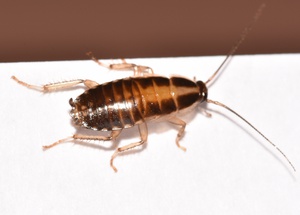BEST TREATMENT FOR GERMAN COCKROACHES PHILADELPHIA, PA
 German Cockroaches are very common roaches in the United States and globally. They are differentiated from other types of roaches by their small body size, two short black stripes running longitudinally from the head to the base of the wings and their coloring ranges from yellowish-brown to brown. Adults measure from 12.7 to 15.88 cm in length with an average of 13.0 cm and weigh between 0.1 and 0.12 g also averaging at 0.105 g. The general appearance of the monomorphic German roach is oval shaped, flat, spiny legs and long antennae. The adults have fully developed wings although they do not fly. The German cockroach nymphs look similar to the adults with the exception of the wings and are smaller in size.
German Cockroaches are very common roaches in the United States and globally. They are differentiated from other types of roaches by their small body size, two short black stripes running longitudinally from the head to the base of the wings and their coloring ranges from yellowish-brown to brown. Adults measure from 12.7 to 15.88 cm in length with an average of 13.0 cm and weigh between 0.1 and 0.12 g also averaging at 0.105 g. The general appearance of the monomorphic German roach is oval shaped, flat, spiny legs and long antennae. The adults have fully developed wings although they do not fly. The German cockroach nymphs look similar to the adults with the exception of the wings and are smaller in size.
Originally from Africa, the German cockroach are commonly found in homes, restaurants, supermarkets, apartments, food processing plants or any other commercial establishments. They thrive well in damp, dark areas including: cracks, crevices of appliances, under the sinks, hinges of cabinet doors, in cabinets, under kitchen appliances, under sinks, behind baseboards or moldings, food stores among other areas with high temperatures and high humidity where they cannot be located easily. They can also be found in cardboard containers or wooden boxes in commercial constructions. You can easily identify their hideouts by looking for their fecal pellets which grounded pepper or coffee grounds. Their feces may also cause staining that may look like dark spots or smears.
German cockroaches can forage on any food; amazingly they even feed on non-food stuffs including soap and glue bindings of books. They also have a tendency to hide in garbage containers and bacteria-laden environments where they can rummage for food. German roaches are resilient and may be difficult to exterminate. Good sanitation is one of the ways to keep the roaches away. Trashing the leftover foods appropriately and sealing the garbage bins, sealing holes and cracks on the walls limit access to their breeding and help keeping them at bay.
LIFE CYCLE OF GERMAN COCKROACHES
The German Cockroach is the fastest reproducing cockroach of all residential roaches. They reach total maturity in around 123 days. Their cycle begins when the female roach develops a sack of eggs which is known as the ootheca. Her abdomen swells as the size of the eggs develops. Once it reaches maturity the color of the ootheca will change until it reaches a brownish color and there the next stage of the cycle starts.
The eggs hatch after an average of 14 to 35 days from the development of the ootheca to the actual hatching of the egg. These little roaches born are now on the “Nymp” stage would develop. They are about 3mm long and will start to molt. The molting is so traumatic to these baby roaches that an average of half of the roaches dies before they reach adulthood. These molted skin are also immediately eaten by the nymphs or by others around it. The nymph period of the German cockroach ranges from the 6th to the 31st week of the roaches life. From then the adult stage begins. Around 20-30 weeks are the given lifespan of an adult roach.
DANGER OF GERMAN COCKROACHES
The dangers that these pests provide are the same with other residential roaches. They have the ability to produce odorous secretions that can change the taste of foods they touch. If there are too many roaches in the area, an odor will become evident in a given household or residential area. There is no proof that the German roaches cause any disease, but the fact that they thrive well in bacteria infested areas it is evident that they carry pathogens of some diseases. Health experts believe that discarded skin sheds is one of the major causes of asthma in urban areas. Like all roaches, these roaches can pick up disease carrying bacteria and viruses from the places that these roaches travel too.
Notable effects are different kinds of gastroenteritis related sicknesses. These can range from diarrhea, dysentery, food poisoning and other diseases. The bacteria or germs that cause these diseases are generally being carried by the leg and bodies of the roach. With the bacteria being carried through the legs of the roach, the carried bacteria are being transferred as they touch and pass through the food



